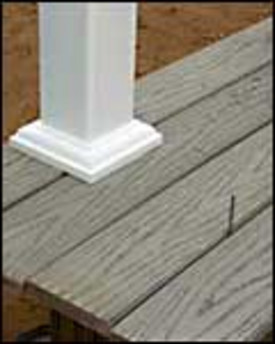 Composite decking looks more like wood than plastic lumber, but must be installed over a pressure-treated lumber base and frame. |
Few aspects of a home require as much maintenance as a wood deck. Exposed to the elements, a wood deck needs sanding, resealing or painting to maintain the desired look and to hold up over time. Although treated wood retains certain resistance properties, moisture and insects still attack, and, like it or not, most wood does give in to rot over time.
It’s no wonder, then, that many are turning to the composite wood and plastic lumber decking options offered by companies such as Trex, TimberTech, CertainTeed, and LP. Billed as low-maintenance or no-maintenance, these durable and environmentally friendly alternatives appeal to the homeowners willing to sacrifice a genuine-wood look for a product that is affordable and worry-free.
Better than Wood?
Most composite decking materials are made from a blend of wood industry by-products or recycled products—wood fibers, sawdust, etc.—and some form of plastic, such as polyethylene or PVC. This 50/50 blend, as it is sometimes called, gives composite decks an engineered resistance to rot and insects, and prevents it from cracking, splitting, or weathering like wood decks. Manufacturers offer warranties as long ten years on these products that require no sealing, staining, or painting.
With manufacturers offering a number of color and texture options, the gap between the look of real wood and the look of composite decking is closing. “We offer earth tone colors—tan and gray—and a smooth finish, a wood grain or embossed finish, and a mildly brushed finish,” says John Pruett, Product Manager for CertainTeed’s Boardwalk composite decking systems.
The use of wood in composite materials gives the product a wood-feel and workability when it comes to installation. Many of the manufacturers also offer complete composite decking systems—from deck boards to rails, posts, and balusters. Although the up-front cost may be more than treated pine—in some cases as much as twice the cost—a homeowner stands to save thousands on maintenance costs over the deck’s lifespan.
A Work in Progress
 Composite decking must be spaced at least a nail’s width apart to allow for drainage between boards. |
Composite decking manufacturers are quick to admit that their products are not perfect. “I’ll be up front about it,” says Pruett, “stains are the leading drawback.” This up-front admission may be in response to consumer criticism of composite decking. Still, it is common to find detailed cleaning instructions included with manufacturers warranty information. LP’s Web site for its WeatherBest composite decking states outright: “Grease will stain any surface. Deal with stains quickly.” Companies are equally up front about the tendency of their products to fade over time. “A deep red composite deck would fade to pink, which nobody wants,” explains Pruett. “This is why we don’t offer a deep red color option.”
These flaws stem from the presence of tannic acid in the wood portion of the composite material. Composite decking made from oak fibers, for example, will have more problems with staining, since oak has a higher tannic acid content. Companies like CertainTeed have found that using maple wood fibers and PVC, rather than oak wood fibers and recycled “soft” plastic, reduce the staining and fading susceptibility of their product. Other companies are tweaking their ingredients to solve these problems.
Molds and mildew are also common enemies of composite decking. Most manufacturers suggest periodic cleanings with deck cleanser to prevent the buildup of these eyesores. Proper spacing between deck boards is also necessary to allow drainage and avoid the buildup of mold and mildew-friendly water pools.
Composite decking materials are also not structurally rated, so a composite deck is still dependent upon treated wood for structural components such as joists and beams. Composite decking is weaker than wood, so a deck not built to manufacturers specifications might experience sagging or drooping.
Plastic Lumber—A True Non-Wood Alternative
Often confused with composite decking, true plastic lumber contains no wood traces. Plastic lumber is primarily composed of recycled plastics—usually up to 90 percent of the product is plastic. “Our plastic lumber is made of 93 percent recycled milk jugs and 7 percent fiberglass,” explains Nathan Kalenich, Applications Engineer for U.S. Plastic Lumber’s (USPL) Carefree decking system and TriMax structural plastic lumber. Plastic lumber first appeared on the decking scene in the mid 90s, around the same time that it discovered an application niche as benches and picnic tables in municipal parks.
Although plastic lumber has yet to claim any significant share of the decking market, it does boast some distinct advantages over its composite competitors. “Unlike composite decking, our product will not fade,” proclaims Kalenich. “It does not stain or absorb water.” The plastic lumber industry also boasts a first in the real-wood alternative decking world—a structurally rated product. USPL’s TriMax can be used for joists, posts, girders, and other structural applications. Significantly more costly than real wood—in some cases up to four times as much—the plastic lumber industry still battles the public perception of plastic decking as a slippery surface. The lack of a big-name manufacturer has also left the industry grasping at a fractional piece of the decking pie.
Credit: Renovate Your World




























